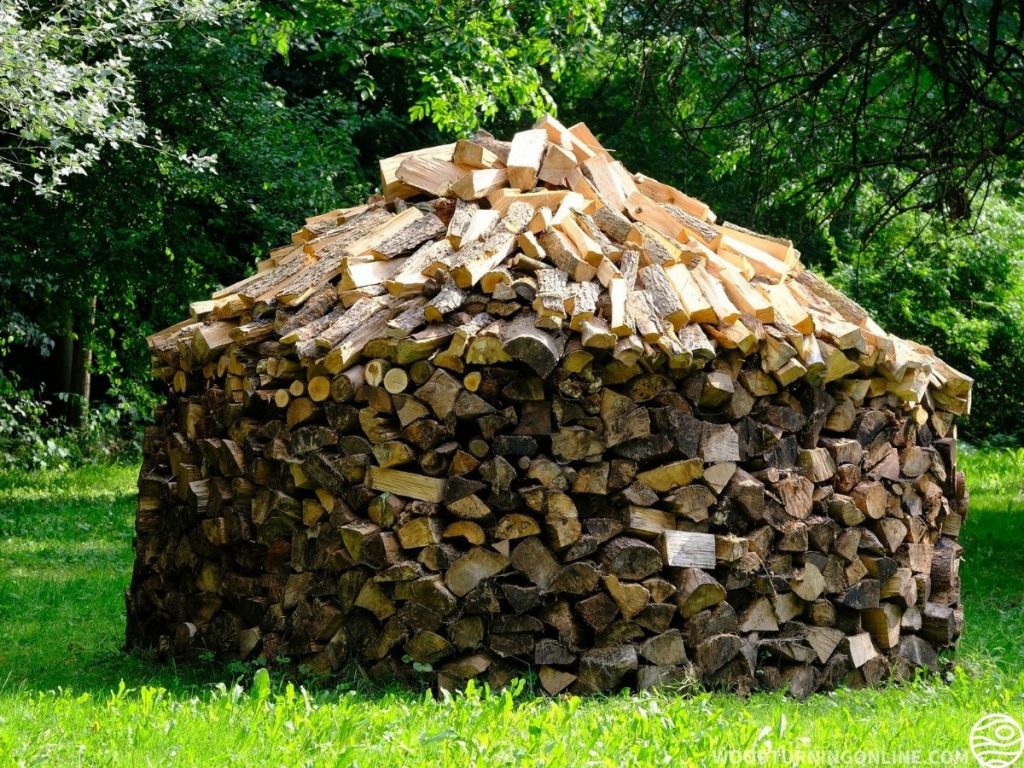This is a small note about why it’s bad for the wood to be too wet or too dry. Read on to learn more. (We’ve written this when we were making our guide on buying lumber at a sawmill.)
Moisture Content

When wood is cut, it usually has a high water content inside the trunk. For instance, when a pine tree is cut down, originally, it has around 100% moisture content or MC.
100% MC essentially means that 50% of the log weight is from the water, while the other 50% is the weight of the wood. When the sawmill cuts the lumber into boards, more portions of the wood are exposed to the air, which enables it to dry more quickly.
Usually, sawmills stack the lumber and put strips of wood in between the boards. This is known as stickering, which lets the air move between the boards, helping them to dry more quickly and uniformly.
How Does Moisture Impact the Wood?
When you’re using lumber in any woodworking project, the most important thing to determine is that the lumber has the proper moisture content level. The level of moisture in the wood depends on the environment’s relative humidity.
And, if the humidity of the area is high, then the wood will absorb the moisture in the air and expand and if the humidity levels fall, then the moisture from the lumber is lost, causing it to shrink.
The optimum level of moisture in the wood is when the wood does not expand or shrink according to the moisture level in the surrounding air and this is known as the EMC or equilibrium moisture content of the wood.
If the lumber you purchase has not dried to the proper levels, does not have proper EMC, and expands or contracts according to the surrounding moisture levels, then it is possible that when you use it in any woodworking project, the boards will start coming apart, which will end up costing a lot, both in terms of expensive repairs and time.
The appropriate moisture levels in the lumber essentially depend on your woodworking project. Typically, the moisture content should be around 6% to 8% before using the wood for your project; however, this level will depend largely on the area where you live.
Measuring the Moisture Content in the Lumber
It’s always a good idea to take along a moisture meter when you go to the sawmill to purchase lumber, which allows you to determine the amount of moisture in the wood so that you can purchase wood having the proper amount of moisture that prevents it from expanding and shrinking when used in projects. There are several types and models of moisture meters available in the market that will make it very easy for you to measure the moisture content in the wood.
The moisture meter essentially works by passing electrical currents through the lumber and records the reading. The faster the current flows to the sensor of the meter the more water content there is in the lumber. There are basically two types of moisture meters available i.e., the pin type and pinless type.
A pin moisture meter contains two needles that protrude from the device. The pins must be pushed slightly into the wood, which records the amount of moisture in it. The pinless meter, on the other hand, does not have pins.
You must simply place the unit on the wood and it will record the amount of moisture in the wood. Most woodworkers prefer the pinless meter because it is much easier to measure the moisture with this model.
How to Dry the Lumber?

Kiln Drying
The best way to get dry lumber is to purchase the wood that has been dried in the kiln. A kiln works just like an oven. However, different types of kilns use different methods to heat the chamber. The drying process using a kiln makes it much easier to control the moisture levels in the lumber. Also, kiln drying helps to kill any bugs or insects present in the wood.
The amount of time that the wood must remain inside the kiln depends largely on the wood species. Typically, conventional kilns using high temperature and high-air velocity dry green lumber that is around 25 mm or 1-inch thick in around 10 hours, where the moisture content is reduced to around 18%, while to dry green Red Oak of 1” thickness needs around 28 days of kiln drying to bring down the moisture content to around 8%.
Typically, mid-sized sawmills own a kiln or have access to one, while small sawmills usually make use of air drying to dry the wood because of the costs involved in the space and the costs involved in installing a kiln.
Kiln-dried wood is generally more expensive per BF; however, the additional cost is definitely worth it. You can also build your own kiln at home for drying the lumber by making use of solar energy.
Air Drying
If the sawmill where you’re purchasing the lumber does not have a kiln or you cannot access a kiln and building one is not an option, then you can adopt the process of air drying to dry the lumber.
You can stack up the boards and air dry the wood. However, the drawback of this method is that it is extremely slow and time-consuming.
Generally, 1-inch-thick lumber takes around 1 year to air dry and likewise, a 2” thick board will take around 2 years to air dry completely. And, if you want to get started on your woodworking project immediately, then air-drying may not be the best option for you.
